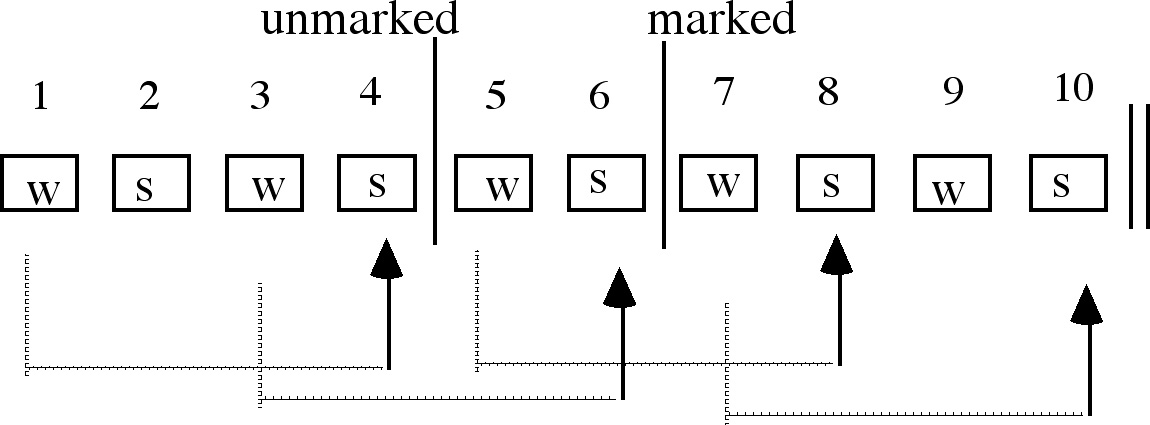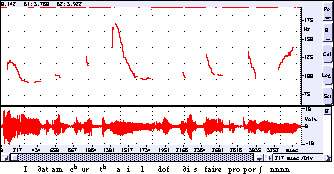Back to home page
Back to "Occasional Papers"
Reuven Tsur
Stress Maximum in the Fifth Position
Rhythmical Performance
This article is a contribution to my perception-oriented
theory of metre and theory of rhythmical performance,
propounded in two of my books (Tsur, 1977; 1998), and
many articles. It focuses on one theoretical issue,
and on a single verse line (Excerpt 1), from Gloucester's
first Soliloquy in Richard III, complementing my argument
in two of my earlier e-journal papers (Tsur, 1997;
2002). The former article explores the rhythmical performance
of stress maxima in weak position; but, at the time,
I couldn't find suitable examples of stress maxima
in the fifth position, the one that is least tolerant
of violation, in a work that has several recordings
by experienced readers. Later I found an exquisite
instance in Gloucester's first soliloquy in Richard
III [Excerpt 1]. In the latter article I analyse Simon
Russel Beale's reading of Gloucester's soliloquy. Since
then I had access to four additional recordings of
the soliloquy. Such a sample provides an excellent
opportunity to make meaningful distinctions that may
yield significant insight into the phenomenon. In what
follows, I am going to attempt just that.
Morris Halle and Jay Keyser were the founding fathers
of generative metrics, proposing a parsimonious rule
which, they claim, can generate all metrical lines,
but no unmetrical ones. A metrical line is one in which
no stress maximum occurs in a weak position. A stress
maximum is, according to the latest version of the
Halle-Keyser theory (1971), a syllable that bears lexical
stress, between two unstressed syllables. Consider
Excerpt 1:

The second syllable of "curTAIL'D of" is a
stress maximum according to this definition.1 Since it occurs in the fifth position (which is odd-numbered
and therefore a weak position in the iambic metre),
this verse line is ruled unmetrical under the Halle-Keyser
theory. Halle and Keyser and their critics all over
the world found about twelve unmetrical lines under
this theory in major English poetry. However, in my
books (Tsur, 1977; 1998) I provided a list of over
52 additional instances (not counting Donne's Satyres).
Such a sample was big enough to suggest some method
in this madness. In an iambic pentameter line there
are four weak positions available for violation under
this theory (positions 3, 5, 7, 9). A random distribution
of violations would allocate, therefore, 25% to each
one. Nearly two thirds, however, occur in position
7; nearly one third in position 3. Most instances that
occur in positions 5 and 9 are fairly doubtful instances.
The line under discussion is one of the very few indisputably
genuine instances. I have argued that a stress maximum
in a weak position is acceptable to such poets as Shakespeare,
Milton and Shelley, for instance, provided that they
can be performed rhythmically; and this distribution
reflects the relative difficulty of doing this. This,
in turn, is influenced by a hierarchy of metric boundaries:
line ending, unmarked caesura, marked caesura —in this
descending order of "grouping potential".
As I have argued in several places, caesura articulates
a verse line in the middle; in the iambic pentameter
line, that cannot be divided into two segments of equal
length and equal structure, it may occur after positions
4, 5, or 6. When a pentameter line is divided into
segments of 4 and 6 positions, "the shorter segment
comes first" is the unmarked option (that is,
when caesura occurs after position 4); "the longest
comes first" is the marked option (that is, when
caesura occurs after position 6).
A stressed syllable in a weak position (a stress maximum
even more so) disturbs metre, and arouses expectations
for reinstatement, "presses forward" for
resolution. When the stress pattern and meter have
again a "coinciding downbeat", tension is
resolved, and the metre becomes "fresh and new".
Metre may be reconfirmed in the next or the next but
one strong position. Only the latter may constitute
a stress maximum. In this case, the period of uncertainty
is longer, the threat to rhythm greater, and the resolution,
if achieved, more gratifying. Position 1 is weak, but
a stressed syllable displaced to it cannot be a stress
maximum by definition. Furthermore, when such a displacement
occurs, meter is reinstated by a "coinciding downbeat"
in position 4, that is, just before the unmarked caesura,
achieving considerable stability. So, it is perfectly
acceptable even to Alexander Pope. A violation of metre
in position 3 is compensated for in position 6, just
before the marked caesura. After a stress maximum in
the ninth position, metre cannot be reinstated in position
10 by definition. A stress maximum in the fifth position
suppresses confirming stress before both potential
metric boundaries (in positions 4 and 6), and must
be compensated for in position 8, which is not followed
by a metric boundary, and where stability is precarious.
Consequently, stress maxima in the fifth and ninth
positions are the least acceptable violations of the
iambic pentameter. The greatest stability is achieved
when the stress maximum occurs in position 7, that
is, when the resolution effected by the next "coinciding
downbeat" occurs in the tenth (last) position
of the line, enhancing its closure.
In a series of empirical studies I have found that experienced
readers tend to perform stress maxima in the seventh
position without questioning, and find the results
satisfying. Though not aware of the required solution,
their solutions tend to be remarkably similar; and
are in harmony with predictions based on the Gestalt
theory of grouping: the deviating stress will be over-
rather than under-emphasised; it will begin a closed
and symmetrical group of four syllables ("stress
valley"), ending in the tenth position; and will
tend to be isolated from the preceding stretch of syllables,
while still taking care of perceptual continuity demanded
by syntax—indicated by conflicting phonetic cues.

Figure 1 Schematic
mapping of possible stress valleys
beginning with a stressed syllable
or stress maximum
in a weak position; the arrows point to the positions
in which metre is reinstated by coinciding downbeats.
I have said that in the case of a stress maximum in
a weak position, the deviating stress is over- rather
than under-emphasised. According to Cooper and Meyer
(1960: 8), in musical performance, the placing of some
extra accent may affect the grouping of sounds. Since
there is a tendency for accents to begin a group, the
placing of accent on a strong beat tends to articulate
the sequence in beginning-stressed groups; an accent
on a weak beat presents the group as end-stressed.
The extra accent in the seventh (weak) position of
the line creates a drive to focus the stress valley
on the last syllable, enhancing the feeling of strong
closure (at the end of the stress valley and the line).
When I wrote my work on the performance of stress maxima
in weak position, I had no suitable examples of stress
maximum in the fifth position, nor a variety of performances
of a single line by experienced readers that could
be compared. More recently I have discovered that Gloucester's
first soliloquy in Richard III. contains an instance.
I have got hold of three commercially available recordings
of the full play, a commercially available CD with
a selection of soliloquies from Shakespeare, and a
website with poetry recordings by Rufus Eagles. Excerpt
1 contains a felicitous instance of a stress maximum
in the fifth (weak) position.
If you are looking for criteria for metricalness, this verse line would
be ruled "unmetrical" by any standard.
First, it is a stress maximum in a weak position. Second,
it occurs in the weak position least tolerant of violation.
Third, some prosodists (Kiparsky 1975, 1977; Magnusson ad Ryder 1970,
and others) allow only stressed monosyllables in weak
positions; they rule unmetrical all instances of polysyllables
that have their stressed syllable in a weak position,
even if no stress maximum is involved. Since in such
Renaissance, Baroque and Romantic poets as Shakespeare,
Milton, and Shelley there is an abundance of disyllables
in SW position, Kiparsky argues for a suspendable stress
inversion rule. Fourth, I have my doubts about this
suspendable stress inversion rule. But even if you
accept it, it "was more widely applicable in the
language of Shakespeare's poetry", says Kiparsky.
"Words like forlorn, extreme, or supreme, and
compounds like unknown and outworn appear systematically
in WS position predicatively and
in SW position attributively". Now, "curTAILED"
is a disyllable in SW position, but a straightforward
verb used "predicatively"; its stressed syllable
constitutes a stress maximum in a weak position, that
happens to be, precisely, the fifth position. It is
hard to imagine a more "unmetrical" line —if you are looking for criteria for metricalness.
Psychologically, "the rhythmical performance"
of a poem is a perceptual solution to a perceptual
problem: when the linguistic and versification patterns
conflict, they are accommodated in a pattern of performance,
such that both are perceptible simultaneously. Ideally,
I ought to play pairs of performances to a great number
of listeners and ask whether any one of them did solve
the perceptual problems. In practice, however, there
are almost insurmountable difficulties even with expert
listeners. Though I have collected from listeners quite
a few illuminating but sporadic rhythmicality judgments,
controlled experiments with great numbers of listeners
appear to be a remote possibility. The rhythmical performance
of a poem is a complex event. If one succeeds at all
in eliciting rhythmicality judgments from a considerable
number of respondents, they may respond to different
subsets of its features, and thus their responses may
not be comparable (cf. Tsur, 2006). Besides, you may get even from professional
respondents such answers as "To my mind, poetic
rhythm only detracts from the poem's meaning",
or "I can't distinguish between vocal performances".
So, the best I can do is something that can be summed
up by adapting two of Morris Weitz's (1962) phrases in his
classic, "The Role of Theory in Aesthetics".
First, I am exploring here not such questions as whether
one should or should not postulate suspendable stress-inversion
rules, or whether the violation of any one of the criteria
for metricality does render a verse line unmetrical,
but whether, given the mismatches, a performance can
be imagined or secured that allows to perceive the
conflicting linguistic and versification patterns at
the same time. Second, since controlled experiments
with eliciting rhythmicality judgments do not seem
feasible at present, I can only make crucial recommendations
as to what to look for in the rhythmical performance
of a poem, and how to look at it. Submitting those
recommendations to public discussions sometimes turns
up surprisingly illuminating results. Furthermore,
if listeners tend to respond to different subsets of
features of the complex event, experienced performers,
per contra, sometimes offer considerable overlap in
their solutions of the same problems. Then one may
examine whether
such solutions do or do not conform with the predictions
of the theory.
For years I had access to only one recording of Exerpt
1, the one by Beale. I tried to apply to it, with the
necessary changes, the conception I developed for stress
maxima in the seventh position, as outlined above.
I'll reproduce here my description and interpretation
of this reading. But it left me with a dim feeling
of dissatisfaction; as will be seen, exposure to additional
readings lead me to reconsider certain aspects.

Figure 2 Wave plot and pitch contour of "I, that
am curTAIL'D
of this fair proportion". read by Simon Russel Beale2
Listen to the line "I, that
am curTAIL'D of this fair proportion", read by Simon Russel Beale